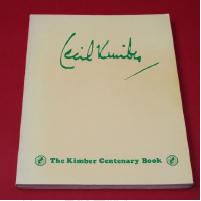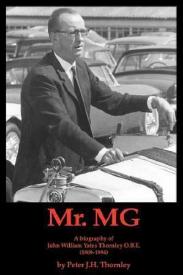|
 Those of you who are reading The Sacred Octagon, the magazine of the New England MGT Register may have seen the three-installment series Owner “MG” Paper, MG History Books. It covers several MG books that describe the various technical details of certain models as well as the history of the entire model line-up, beginning in the 1920s and up to today, including MGs that have never been available in the United States of America since formal import stopped with the end of the MGB production in 1980. Most of the books described in the article are on one of these shelves in our house. Those of you who are reading The Sacred Octagon, the magazine of the New England MGT Register may have seen the three-installment series Owner “MG” Paper, MG History Books. It covers several MG books that describe the various technical details of certain models as well as the history of the entire model line-up, beginning in the 1920s and up to today, including MGs that have never been available in the United States of America since formal import stopped with the end of the MGB production in 1980. Most of the books described in the article are on one of these shelves in our house.

 However, I have two books, not covered in the article, which I consider most important on the history of the marque and the lives and visions of the two men who made MG into the car we all like so much. However, I have two books, not covered in the article, which I consider most important on the history of the marque and the lives and visions of the two men who made MG into the car we all like so much.
 The first one of these two is, of course, Cecil Kimber, who started Morris Garages in the early 20s, made it into M.G. (Yes, with periods at that time) in 1923, and was the General Manager until the beginning of WWII. The first one of these two is, of course, Cecil Kimber, who started Morris Garages in the early 20s, made it into M.G. (Yes, with periods at that time) in 1923, and was the General Manager until the beginning of WWII.
 The most complete book about him is Cecil Kimber, The Kimber Centenary Book, published by The New England MG T Register and edited by Richard Knudson. (ISBN 0-938253-01-8) As the title suggests, it was published on April 12, 1998, Cecil Kimber's 100th birthday. I think that it is currently out-of-print, The most complete book about him is Cecil Kimber, The Kimber Centenary Book, published by The New England MG T Register and edited by Richard Knudson. (ISBN 0-938253-01-8) As the title suggests, it was published on April 12, 1998, Cecil Kimber's 100th birthday. I think that it is currently out-of-print,
 but an updated issue is in the works and it comes up on eBay and similar sites frequently. The chapter by Jean Kimber Cook (daughter) is the longest and tells the story and background of Cecil’s life. Augmented by chapters of people who knew him well or worked with him, the book presents a very complete insight of the person, his vision for the company, and his style in running it. Almost all the second half of the book is dedicated to several papers Cecil Kimber presented to professional organizations in England, covering design, motor racing, and the market for sports cars. It is here, in these presentations and illustrations that the true genius of Cecil Kimber is shown. When WWII broke out, Cecil Kimber turned the factory in Abingdon around to start the production of parts for airplanes and tanks. He did so without following proper procedures in the Morris organizations and was asked to resign. Unfortunately, Cecil Kimber was killed in a tragic train accident on February 4, 1945 at the age of 56 years and was never able to enjoy the post-war success of his brain-child MG.
but an updated issue is in the works and it comes up on eBay and similar sites frequently. The chapter by Jean Kimber Cook (daughter) is the longest and tells the story and background of Cecil’s life. Augmented by chapters of people who knew him well or worked with him, the book presents a very complete insight of the person, his vision for the company, and his style in running it. Almost all the second half of the book is dedicated to several papers Cecil Kimber presented to professional organizations in England, covering design, motor racing, and the market for sports cars. It is here, in these presentations and illustrations that the true genius of Cecil Kimber is shown. When WWII broke out, Cecil Kimber turned the factory in Abingdon around to start the production of parts for airplanes and tanks. He did so without following proper procedures in the Morris organizations and was asked to resign. Unfortunately, Cecil Kimber was killed in a tragic train accident on February 4, 1945 at the age of 56 years and was never able to enjoy the post-war success of his brain-child MG.

 The second is John Thornley, the man who took over after WWII and made MG into an export machine generating the much-needed cash (US Dollars) for the recovery. The book Mr. MG was written by his son, expat, and former Peachtree MG Registry member Peter Thornley. (ISBN 978-0954312107, currently available from many sources) The second is John Thornley, the man who took over after WWII and made MG into an export machine generating the much-needed cash (US Dollars) for the recovery. The book Mr. MG was written by his son, expat, and former Peachtree MG Registry member Peter Thornley. (ISBN 978-0954312107, currently available from many sources)
 The book describes the life of John Thornley, going back to the days in the 30s when he joined Cecil Kimber’s company and started the factory backed MG Car Club. The most impressive sections are how he was able to navigate the corporate intricacies of the Morris organization in all its variations, while maintaining focus on developing cars that would sell well in the all-important export markets of which the US was the most important. The book also goes into great detail of John Thornley’s personal relationship with European importers and the US dealer organization. When factory closure was announced, John Thornley had already retired form the company, but the book also covers his engagement to try to keep the factory open, with presentations and letters to the government and the American dealers. The book describes the life of John Thornley, going back to the days in the 30s when he joined Cecil Kimber’s company and started the factory backed MG Car Club. The most impressive sections are how he was able to navigate the corporate intricacies of the Morris organization in all its variations, while maintaining focus on developing cars that would sell well in the all-important export markets of which the US was the most important. The book also goes into great detail of John Thornley’s personal relationship with European importers and the US dealer organization. When factory closure was announced, John Thornley had already retired form the company, but the book also covers his engagement to try to keep the factory open, with presentations and letters to the government and the American dealers.
 Both books offer great reading for the 2020 Summer-at-Home and will give you a much broader insight in the two men who we must thank for the two-letter initials in our club’s name. Both books offer great reading for the 2020 Summer-at-Home and will give you a much broader insight in the two men who we must thank for the two-letter initials in our club’s name.
~~ Reinout Vogt
|